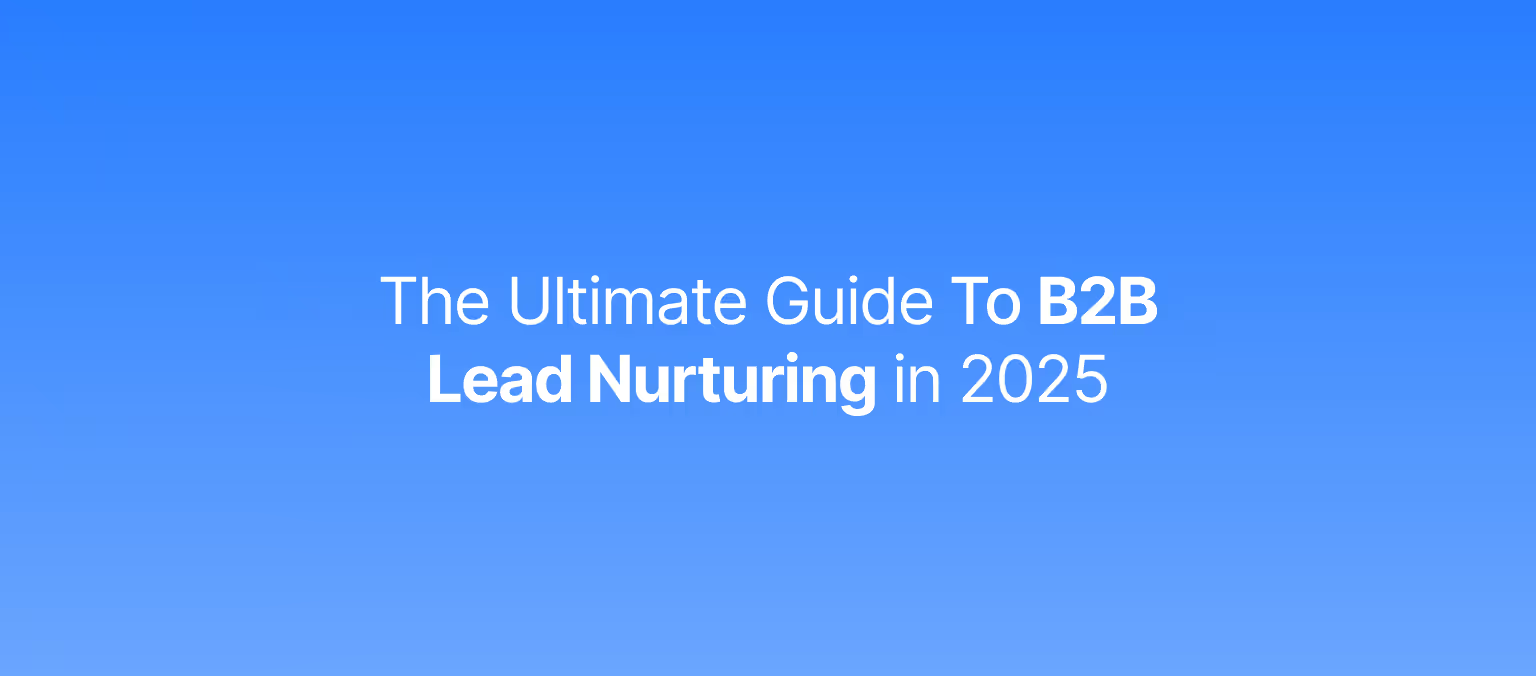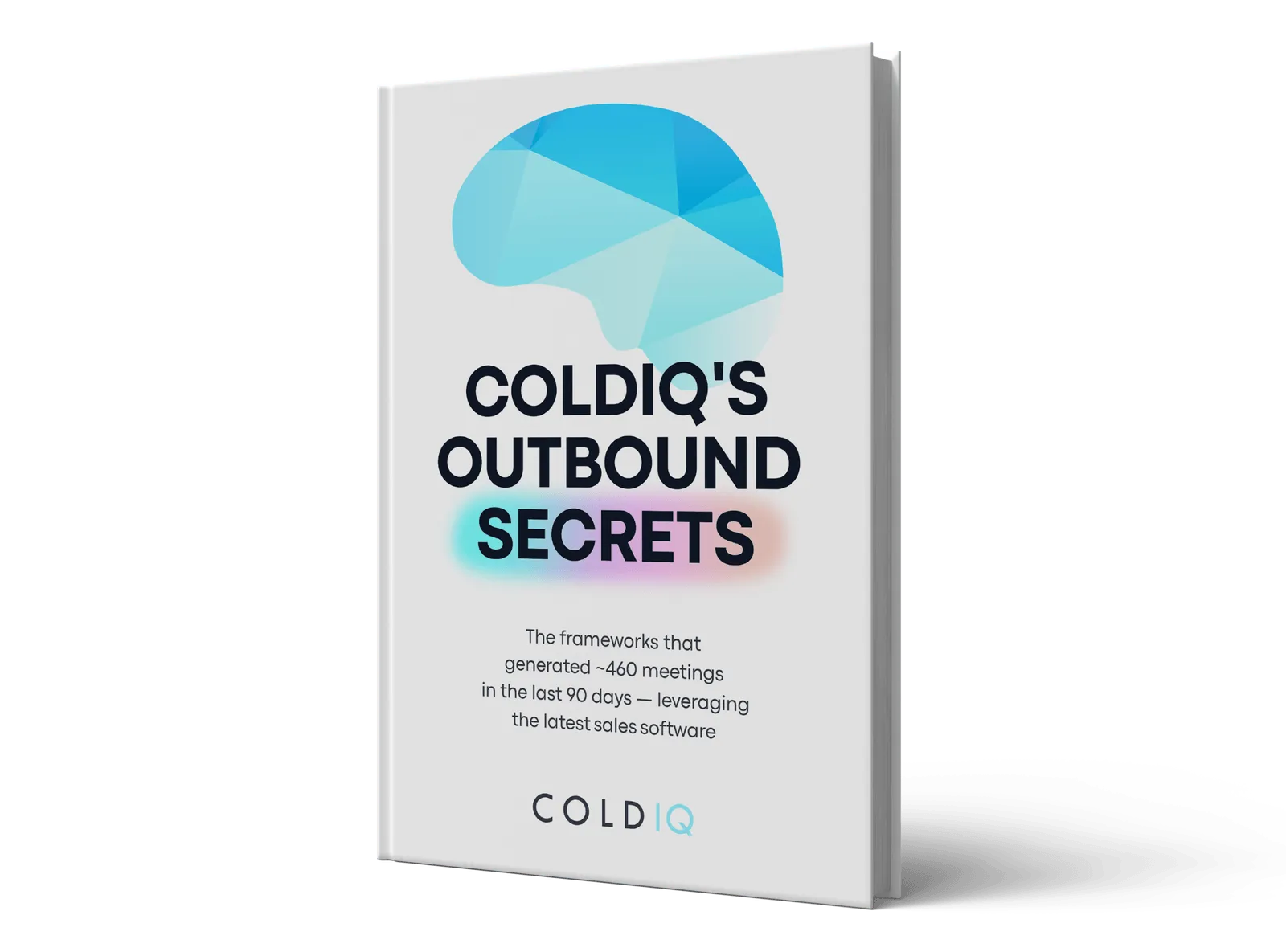What if your targeted leads aren’t converting?
You’ve redesigned your website, refined your ads, and your CRM is filled with ideal contacts – yet, deals keep falling through the cracks. The real problem here isn’t a lack of leads; it’s that most B2B sales and marketing teams could treat them the same or push too fast.
This is where B2B lead nurturing changes the game. When done right, it transforms your passive contact into engaged prospects who trust and see the value in your solution, prompting them to have that sales call with you.
In this ultimate guide, we explored what B2B lead nurturing means, its importance, and how to create a perfect nurturing plan. Let’s get started.
What Is B2B Lead Nurturing?
B2B lead nurturing refers to the process of developing relationships with prospects who have expressed interest in your products or services. It’s effective at different stages of the sales cycle, enabling you to understand their needs and offer the most appropriate solution.
When you show that you can solve your prospect’s problem through personalized content and messaging, they can trust your business, and such continuous engagement results in conversion.
An effective lead nurturing is more than just automated email sequences in B2B marketing and sales. It relies on multiple channels such as social media platforms, content marketing, and targeted ads.
Since the customer’s journey is longer, businesses employ these channels to capture their attention, shorten the sales cycle, and improve ROI.
How Important Is Lead Nurturing For B2B Companies
Lead nurturing offers various benefits for B2B companies. Here’s a quick snapshot of what strong B2B lead nurturing can actually deliver when done right:
Let’s add a few details:
1. Establish contact with prospects
People lose interest quickly. If a lead doesn’t hear back from you quickly, they may lose interest or even forget why they contacted you in the first place.
A study revealed that contacting a lead within the first 5 minutes makes you 21x more likely to turn them into a sales opportunity compared to contacting them after 30 minutes.
In short, lead nurturing helps you to establish contact with prospects and increases the chance of connecting with them, rather than losing sales opportunities.
2. Builds trust
People engage in business transactions with those they trust.
Lead nurturing allows you to showcase yourself as an expert in the field, creating trust in your prospects and building an authentic relationship with them. That alone opens the door for future sales.
3. Identify their pain points
Lead nurturing is a great way to understand your potential customers — their challenges, needs, and interests — so they can provide value.
When your sales team presents different types of content that resonate with them or asks them questions about their needs, you pre-qualify your leads and set them up for warm sales conversations.
4. Improved ROI
Sales-ready leads mean more sales. We don’t just say it. The stat backs it up, with 47% of nurtured leads committing to larger purchases.
Once you tailor your content to your prospect’s needs, you reveal more cross-sell opportunities, which tends to increase sales and maximize your return on investment.
Stages of the B2B Lead Nurturing Funnel
Before you think of nurturing a lead, you must first consider every stage of their buyer’s journey to align the right content with their needs.
Here are four stages you should consider:
1. Awareness: capturing attention without being too aggressive
The awareness stage is when the prospects become aware of their problem.
In some cases, they may not even be aware of your product specifically but understand they have a challenge and want to learn about it.
So, they start looking into what’s going on, why it happens, and how to address that situation. They’re in the earliest stage of finding solutions to their problem.
Your job here isn’t to directly sell to your prospects, but to offer valuable content to meet their needs. Whether it’s blog posts, videos, or how-to guides, provide resonating content that clarifies their existing challenges and offers possible approaches to solving them, without being salesy.
For instance, as a B2B design company, you can offer templates or checklists on how to design without necessarily pushing for sales.
2. Consideration: educating and providing value
In the consideration stage, your prospects are aware of their problems and are actively looking for ways to solve them.
While exploring, they consider solution offerings from a variety of businesses. They could compare approaches, strategies, or tools, and start to figure out which one would be the best fit. They examine the pros and cons and evaluate every option that’s available to them.
In this case, your content doesn't necessarily sell to them, but can position your brand as the solution to their challenges. Think of comparison guides, case studies, webinars, or email sequences.
For instance, a “How we help SaaS startups increase user onboarding completion rate by 42% after a UX redesign” case study speaks to potential buyers who struggle with user onboarding due to poor design and positions the brand as the best solution.
3. Decision: guiding leads to choosing your solution
At the decision stage, the person is about to make a purchase. But before that, they need validation that your product actually delivers what it promises. What makes your brand the best solution to their problem? This is where you make your messaging product-focused.
Provide content that reinforces credibility and helps them to visualize success with your company. Share customers’ success stories, testimonials, or product reviews.
You can also provide interactive tools like ROI calculators to help buyers understand the impact of your solution on their finances.
4. Post-decision: onboarding and retention as part of nurturing
At the post-decision stage, your prospects have chosen your product or service. As a result, you should help them feel more confident with their choice and let them see the ongoing value.
One way to do this is to make the onboarding process smooth. Provide welcome emails and guides that clearly explain the steps. You can also provide walkthrough videos or tutorials to show them how to get started.
Retaining your customers is another vital part of the nurturing process. Have a dedicated help center to answer questions or address any issues they encounter. Publish up-sell and cross-sell content to create new opportunities. The goal is to make them feel part of a community rather than just getting their money.
Also read: How AI for Outbound Sales Can Boost Your Results
How to Create a Perfect Lead Nurturing Plan?
Now that we have touched on the stages of a B2B lead nurturing funnel, let’s talk about how to create a perfect lead nurturing plan.
Step 1: Define your buyer personas and their journey stages
Your buyer persona isn’t some marketing exercise to check off the list. It’s what reflects your target audience and helps you determine how to transform cold leads into engaged conversations and paying customers.
A buyer persona is an in-depth description of your ideal customers based on market research and real data about your existing customers. It contains specific information such as demographics (age, gender, location), behavioral patterns, motivations, challenges, or goals.
Understanding what your prospects are looking for helps you create the right messaging at the right time. This will help to craft well-tailored content and contribute to a more effective buyer journey.
Here’s a three-step process to crafting your buyer persona for successful lead nurturing:
- Audit your existing personas: If your current persona focuses on demographics rather than buying behavior or psychology, that requires an overhaul.
- Interview your customers: Find your existing customers and ask questions. Don’t just ask them what they do. Instead, ask them about how they felt during the buying process, their likes and dislikes, the challenges they faced, and what convinced them to move forward with you. Getting these answers provides a deeper insight into understanding your customers and how your products work for them.
- Segment your audience: From the information you have gathered, map the audience that aligns with specific data. Look for behavior or commonly repeated remarks or phrases that indicate their interest. That’s your buyer persona.
Step 2: Set lead qualification and scoring criteria
Once you’ve defined your buyer persona, the next step is to qualify them based on specific criteria. Lead qualification is the process of determining if a lead is the best fit for your business. It allows you to score your leads based on pre-defined criteria such as age, location, and web behavior, such as a visit to a pricing page.
A lead is awarded points for multiple variables, giving them a score to help them determine how likely they will make a purchase. Once they’re scored, a lead is segmented into different groups and interacted with based on their stage in the different sales cycles. For example, those who are marked as “hot” may be invited to schedule a demo.
Meanwhile, those who are marked as “cool” may be invited for a webinar. In short, lead qualification is essential for gauging how valuable a lead is to your business based on the potential for sales or their likelihood to be closed.
Step 3: Map content to each funnel stage
If you’re not mapping content to each funnel stage, chances are your leads are drowning in irrelevant information at the wrong time. Mapping content to each funnel stage shows you have exactly what your prospects need and when they need it.
For every stage, there is a corresponding content to align with the ideal buyers in that niche.
Mapping content to each funnel will not only drive engagement but ultimately build credibility that increases the chances of having more sales for your business.
Step 4: Choose your channels (email, LinkedIn, events, etc.)
Lead nurturing isn’t about being everywhere. It’s by choosing the right channels, specifically one that moves the needle for your specific buyers. According to McKinsey research, the average B2B customer uses an average of ten channels during the buying journey.
However, being present on these channels isn’t enough. You need to create a seamless omnichannel experience that gently pushes them throughout the sales cycle. Here are a few ways to engage your prospects:
- Use a chatbot to answer your prospect’s inquiries in real time.
- Create a welcome email sequence to make them feel more valued.
- Engage on socials, especially LinkedIn, to continue the email conversation.
- Follow up with SMS or phone calls to nudge them for a demo call or invite them to an event.
- Schedule a demo call to walk them through how your products can solve their problems.
Discovering your prospects in places where they want to be found is a game-changer. When you show up at the right place at the right time, you create a better engaging experience for your prospects.
Step 5: Automate with tools and monitor with metrics
A manual approach to lead nurturing will leave you exhausted and frustrated. So rather than burning out by crafting personalized emails for every single lead or manually following up, stick to automation.
Automation isn’t being robotic or having the machines do all the work for you. They automate the repetitive tasks and create a reliable foundation so that no lead falls through the cracks.
So instead of tracking your leads manually, you can set up a workflow to craft personalized messages and send them to your prospects at intervals. This allows you to focus on more demanding matters.
In addition to automation, tracking your campaign performance is also essential. Measure how leads move through the nurturing stages over time. Check the messages and channels that generate actual responses from prospects.
Measure how long it takes for each lead to progress across each stage. Having this detailed information on your campaign’s performance enables you to know what’s working or needs improvement.
Step 6: Include a downloadable checklist or linkable framework if possible
Using a downloadable checklist or linkable framework helps with the heavy lifting in your nurturing sequence. That’s because they deliver actual value that keeps prospects engaged for months.
When you share a checklist or framework with your prospects, you’re not only giving information but creating a shared language with them. They use your terminology and frame problems like you do. So when it’s time to buy, they view you as an expert in that field.
Here are some tips for your checklist or framework:
- Start with your prospect’s pain points
- Map your content to each stage of the buyer’s journey
- Make it scannable and actionable. Use clear headers and bullet points to enable your prospects to skim the content easily.
- Include natural follow-up points for future steps.
Overall, having a well-executed framework will generate qualified conversations rather than generic content that gathers digital dust on your website.
Also read: 8 Best AI Lead Generation Tools in 2025
B2B Lead Nurturing Best Practices
While you have an amazing B2B lead nurturing strategy, your implementation process is what determines its success.
This is where the need for lead nurturing best practices arises. Below are the six best lead-nurturing best practices you can follow:
1. Use segmentation and personalization (by role, industry, or behavior)
Not every lead is equal, and prioritizing every lead may drain your efforts and waste resources.
Hence, segmenting leads into groups is a smart way to run your nurturing process and make sure the right people receive the right messages. Here are different ways you can segment your leads:
- Demographic segmentation → By company size, job title, and industry.
- Geographic segmentation → By timezone, region, or country.
- Behavioral segmentation → By website interaction (page visits, downloads, or time spent), product usage, or content engagement.
- Needs-based segmentation → By desired features or specific challenges.
- Engagement-level segmentation → By new leads, active users, or inactive ones.
- Customer-journey stage → Awareness, consideration, or decision stage.
- Technographic stage → By current tech stack or software compatibility.
Aside from segmentation, personalization is also crucial to B2B lead nurturing. Using personalized content demonstrates that you have a deep understanding of your prospect’s challenges and needs, enabling you to build trust.
Anthony Natoli, Senior Account Executive at LinkedIn, says, “People book meetings when you’re talking about the relevant problems to the right persona at the right time.” In other words, without addressing your prospect’s problems, selling to them becomes challenging.
Due to this, it’s best to leverage data from past interactions to inform your content strategy, ensuring each touchpoint is meaningful to your prospects.
2. Don’t push leads too fast down the funnel
Given that it takes 31 touches to close deals, pushing leads too fast can let you skip some critical steps where understanding, trust, and credibility are built. Lead nurturing is a process where you move prospects at a pace that matches their readiness to buy.
Without these critical steps, they would feel pressurized rather than being supported. To avoid this mistake, take the time to guide your leads properly. Listen actively to their needs and qualify properly at each stage. For instance, you can use behavioral triggers to nurture without annoying. If a prospect downloads multiple content in a week, that’s a signal to increase frequency. This approach keeps them engaged and moves them forward naturally.
3. Keep content educational, not just promotional
When your content feels like a sales pitch instead of a guide, your prospects won’t engage. You don’t have to talk to them about directly buying your products; you have to show them instead. This isn’t about sending a few emails that focus purely on features and asking them to join a demo invite.
Instead, share valuable content that answers their real questions. Explain the common pitfalls in the industry or walk them through how their peers solved their questions. Let every content focus on them and their challenges. This approach lets them earn trust and feel safer moving forward with you.
4. Use lead scoring to prioritize efforts
Not every lead deserves priority in your sales funnel. In a bid to chase every contact equally, they will only waste your efforts and resources. Instead, use lead scoring to prioritize the signals that matter.
For instance, you can create a point-based system for every interaction on your website — email opened, downloaded files, site search, or pricing page visits. You can assign 100 points for a hot lead, 50-100 points for a warm lead, or less than 50 points for a cold lead.
This helps determine which leads you should spend more time with and less on those who aren’t of priority at the moment.
5. Follow up consistently but non-intrusively
Bombarding prospects with daily follow-up emails or messages could frustrate them and, even worse, block you. Consistent follow-ups aren’t about frequency — they’re about value, timing, and relevance.
Before you send that follow-up message, ask yourself, “What’s in it for them?” Does it solve their problem, provide relevant industry insight, or introduce them to a meaningful connection? If you can’t articulate the value in one sentence, don’t send it.
Also, build a breathing room in your sequence. Alex Vacca, co-founder of ColdIQ, shared a framework for following up with prospects without being pushy.
- Day 2 → Suggest a meeting time after two days of no response.
- Day 4 → Ask them for a time that works with their schedule.
- Day 10 → Check if the core problem discussed is relevant
- Day 20 → Share a targeted case study demonstrating social proof
- Day 50 → Provide a valuable insight, guide, or industry update.
- Day 100 → Share relevant content like case studies.
According to him, the key is to stay on top of mind without being pushy.
He adds, “The more time passes, the less personalization is needed, but early touchpoints should showcase creativity, competence, and personalization. Consistency, persistence, and value - that's the formula.”

6. Regularly review and optimize nurture sequences
No matter how good your nurture sequence is, it doesn’t last forever. Reviewing and optimizing nurture sequences opens the door to a new tactic that blows the previous strategy out of the water. Every week, measure the performance of your lead-nurturing campaign.
Look at the email open rates, the demos booked, or event registration. If an activity isn’t working well as you expected, make some changes till you see noticeable improvement. If the activity performs well, continue to invest in it.
B2B Lead Nurturing Examples
Looking for some real-world examples of B2B lead nurturing? Here are some samples to guide.
Example 1: How DDC helped PCO bookkeepers to double their growth in two years
The Challenge
PCO Bookkeepers and M&A specialists, an accounting service firm, experienced a three-year period of flat year-over-year sales. Although they had 10,000 targeted leads, an active social media presence, and the basic tools, the result wasn’t showing up in numbers. They wanted to achieve a bigger revenue.
The Transformation Process
They partnered with Digital Demand Center (DDC) to audit their existing online content and launch a series of lead-nurturing and other marketing campaigns to generate leads and increase sales growth. They also introduced some changes to their sales tech stack. For instance, they migrated their existing CRM to Salesforce to support the campaigns.
The Results
Within 18 months, DDC generated 300 marketing-qualified leads and 14-18 sales-qualified ones. The firm was also able to reduce its monthly fixed cost of sales within one year. Overall, DDC increased the firm’s sales growth by 100%.
Example 2: How Ceros boosted its lead generation efforts with HubSpot
The Challenge
Ceros, a cloud-based interactive content creation platform focused on improving brand awareness and generating high-volume leads. At first, they used tools like Salesforce and Marketo but couldn’t use them effectively. While Marketo lacked clear visibility into contacts’ engagement, Salesforce proved to be complex.
The Transformation Process
Ceros turned to HubSpot to align its marketing and sales efforts. HubSpot’s inbound marketing software provided full visibility into their contacts’ interactions with their emails, websites, and social channels. This allowed them to identify the most and least effective elements in their campaigns.
Besides, HubSpot’s reporting tools enabled Ceros to launch its broad lead-nurturing and behavior-based follow-up campaigns. For instance, they could send an automated follow-up to a group that would watch 100% of their demo videos.
The Results
Thanks to this systematic nurture workflow, they witnessed a 900% increase in marketing-qualified leads, a 400% increase in sales-qualified leads, and a 700% increase in monthly meetings.
Example 3: Diving into Groove’s onboarding campaigns
The Problem
Groove’s onboarding sequence was underperforming, with its average open rate hovering around 28% and conversion rate, 8%. The problem wasn’t their website redesign; it was more about the relevance of their emails.
At first, their onboarding sequence centered on one goal: get more people to use Groove. That didn’t bring much result. So, they changed their approach, including their onboarding emails.
The Transformation Process and Results
In this process, Groove tested different elements of emails such as subject, bodies, call-to-actions, and more. They tracked each metric closely to determine which had the biggest impact on users and ultimately, on trial-to-conversions. They tried three series of emails:
- The “You’re In” Email: This first email came from their CEO asking them the question, “Why did you sign up?” This personal touch boosted the response rate by 41% and boosted trust.
- Behavioral triggers: Instead of a one-size-fits-all approach, they launched and tailored a series of emails based on users’ behaviors, depending on what they did or didn’t do. This increased their trial-to-conversion rates by 10%.
- The “Win-Back” Email: This was for users who had abandoned Groove. They tested win-back emails at 7,21, and 90 days to re-engage users. The 90-day email alone generated a 2% conversion, recovering revenue that could have been lost.
Also Read: 8 Best CRM for Outbound Sales in 2025
Key Metrics to Track Lead Nurturing Success
Here are some key metrics to track for an effective lead-nurturing campaign.
1. Engagement metrics (CTR, open rate, content interaction)
Engagement metrics demonstrate how users interact with your content and how close they are to making a purchase. Common metrics to track here include:
- Content engagement: Track the number of views, shares, or downloads of your content.
- Email engagement: Monitor the email open rate, click-through rates (CTR), and conversion rate (percentage of people who performed the desired action).
- Website activity: Analyze the amount of time spent on specific pages or track the pages visited.
2. Funnel progression (MQL to SQL to opportunity)
The funnel progression from marketing qualified leads (MQLs) to sales qualified leads (SQLs) shows the customer’s journey through the sales pipeline. While MQLs are in the awareness and consideration stage, the SQLs are in the decision stage.
It’s, therefore, essential to nurture the leads with the appropriate kind of content for each stage to create a loyal customer base and achieve results.
3. Conversion rate and ROI
The conversion rate and return on investment (ROI) are closely related. While a higher conversion rate implies that more users are performing the desired action, a higher ROI, means your marketing efforts are efficient and generate more revenue than they cost.
This helps to determine the profitability of marketing campaigns and make informed decisions about future investments.
4. Lead velocity and lifecycle length
Lead velocity measures the rate at which qualified leads are generated in a given period, typically month-over-month. On the other hand, the sales cycle length is the average time it takes to close a deal, from initial contact to the final purchase.
To help you track what actually moves the needle, here's your lead nurturing dashboard — with benchmarks and tools included. Keep this handy!
Conclusion
B2B lead nurturing requires precision and a strategic approach. It’s a journey filled with learning, experimentation, and lots of changes. But if done correctly, it can drive engagement, yield quality leads, and boost their ROI.
ColdIQ implements an omnichannel approach to nurturing your leads across every stage of the sales funnel. Our sales experts leverage AI sales tools and execute the right B2B lead generation strategies to keep your leads nurtured throughout the sales cycle.
Book a GTM Strategy Call with us today!




.avif)

.svg)
.avif)



.avif)
